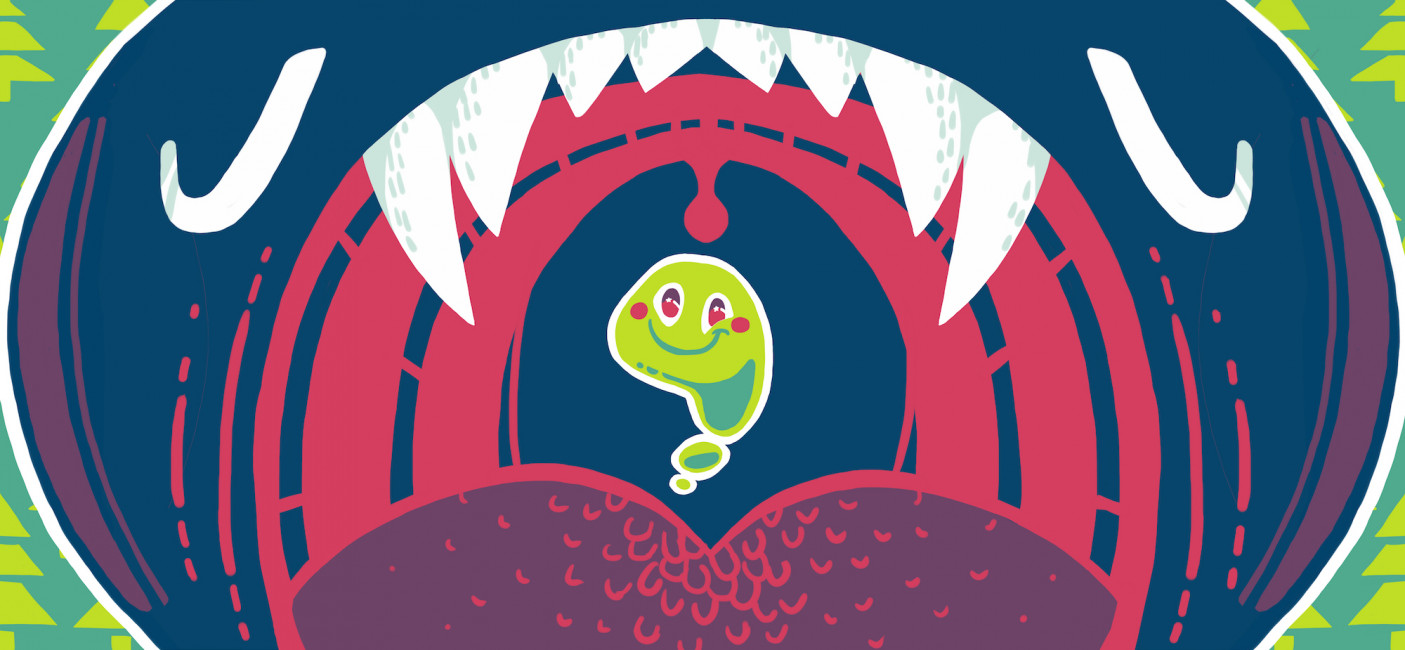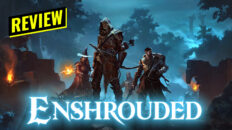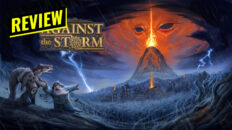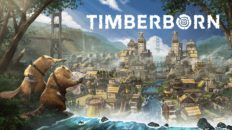Developer: Fabraz
Publisher: Headup Games
Reviewed on: PC
Code Received
There’s so much to love about Slime-san. Its stunning retro presentation, tight controls, and constant introduction of different mechanics means you will be wide-eyed, white-knuckled, and just a bit infuriated during your fifteen-to-twenty-hour initial playthrough.
Slime-san is light on story and still manages to be heavy on character and charm. Slime-san is a ball of slime (with an unnamed white bird companion) that has just been gobbled up by a massive world destroying worm. The player must make their way through the worm’s insides to escape, avoiding traps and defeating internal body parts/organs which serve as bosses.
Much in the vein of Super Meat Boy, Slime-san is a 2D retro platformer with an emphasis on speed. There are 100 levels, each with four rooms or stages, and every 20th level is a boss battle. A timer keeps track of how you are doing and resets at the beginning of each four-room level. Each room will task the player with collecting an optional green apple (which serves as the game’s currency) and then reaching the goal, indicated by an arrow sign. Basic moves include a single jump, wall jump, and dash. There is no true double jump, but you can fall from a ledge without jumping and then activate your jump in mid-air, or gain another mid-air jump after touching any surface while falling. Later levels feature wind currents, trampolines, warp portals, and gravity zones that behave as expected. All of this is handled by precise, consistent controls. While dying is inevitable and an often occurrence, it rarely feels cheap and unavoidable.

Slime-san’s biggest strength lies in its commitment to easing the player into a new ability or mechanic, before ramping up the difficulty to test what the player has learned. Any damage taken is a death. Early on, you will simply be jumping over enemies and pits or dodging slow moving projectiles. As you progress you will encounter faster moving hazards and more dangerous enemies that adapt to your movement and in some cases even chase you before blowing up. Every time it started to click and things were getting easier for me, a new enemy type or environmental hazard would get thrown in, and I would spend the next several minutes trying to adjust. However, I enjoy a fair challenge and because Slime-san immediately respawns you in the same room in which you just perished as opposed to the first room of a given level, the impact of death is minimal.
There is a fine line between “challenging and fun” and “I hate this game.” Slime-san mostly gets it just right, with the exception of boss battles. The bosses are certainly tough, but their difficulty is not why I find them to be the most frustrating portion of Slime-san. These epic battles often combine rounds of dodging attacks with platforming segments to reach new areas to continue or progress the fight. Transitioning from one-minute-or-less rooms to multi-phase boss battles that take five minutes can be outright jarring. Until you learn their attack patterns, you have little choice but to die a few times. Regardless of which phase you reached previously you are instantly banished to the beginning of the fight with each death.

Inside this behemoth worm lives a cast of quirky, sometimes hilarious characters who have accepted their fate to live forever inside this worm. They have founded Slumptown, a bustling colony inside the worm, complete with shops where you can buy different play styles, visual effects to alter the graphical presentation slightly, and sharp threads for you and your winged partner. The first shop you come to in Slumptown (ran by Fernando; has a big pill sign) allows the player to buy new characters. They are still green slime beings, but they have various ability sets. One may allow for a higher jump, while taking away the ability to dash up. My Slime of choice counters slower walk speed with a second mid-air dash. This made later levels much more approachable as I could swap out play styles to suit the challenge before me.
While the quick platforming is addicting and challenging, the real star of this package is its stylistic presentation. The 8-bit art style is fantastically realized here. You get a feeling that developer Fabraz spent a ton of time designing this world. The insides of the worm are painted deep dusk blue, and provide a perfectly muted backdrop for the more intensely colored action up front. Slime-san (as well as enemies he can jump on without taking damage) are bright Nickelodeon Slime green. Surfaces that Slime-san can touch safely are white. Objects that will kill you with one touch (enemies, a giant wall of acid, surfaces with acid on them) glow a vibrant neon red. This can be a very fast-paced game, and the choice to use a few colors that serve as visual cues really pays off as it allows the player to quickly assess a room before choosing the path he or she takes.

Another great use of color here are the slime trails you leave as you bounce and slide through the room. Your neon-green slime is left on all surfaces you have touched, including environmental hazards that take your life. It all comes together to serve as a visual reminder of where you have previously tread and which traps have killed you.
Of course any game that looks and plays this excellently should also sound great, and the soundtrack does not disappoint in any way. Over 10 chiptune composers lend their talents to an absurdly catchy soundtrack. The resulting frantic jams enhance the experience of flowing from one room to the next, and I actually found that playing with the music switched off lead to lesser sense of urgency. As the lava-like wall of acid rises and threatens to eradicate Slime-san, the music warps in pitch helping to alert the player they are running out of time to complete the current room.
Aside from the music, other areas of Slime-san’s sound design are also exceptional. Text is displayed during dialog, and the character’s voices are handled similarly to how Rare would voice characters in the Banjo-Kazooie days. That means we have pitched mumbling in place of real words. I found it an endearing and welcome nod to retro game design.
Slumptown and its shops can be accessed at anytime via the pause menu. There are a few neat references and easter eggs sprinkled throughout Slumptown that are sure to keep the player engaged as well, such as a worm named “Jim” who wears a spacesuit and refers to the antagonistic giant worm as his mother (his relevance to you will likely depend on your age). Slime-san also has its share of distractions for you once you complete its lengthy main story. “New Game+” mode sees all 100 levels (remember, four rooms in each) remixed for a familiar-yet-different experience. “Boss Rush” mode is also a welcome addition here for the more determined and skilled (don’t look at me).
Of course all of these modes include leaderboard support, with the odd exclusion of my favorite, “Target Mode.” This is essentially the long-missed target smash mode from the original Super Smash Bros. Besting the par time on all ten courses will require near perfect runs, so it is recommended this mode be played after finishing the story.

You may also find an arcade within Slumptown in which you can buy mini game versions of other classic titles, which even offer local multiplayer. Using in-game currency, you can unlock bite-sized renditions of DOOM, Super Mario Kart, Zelda: A Link to the Past, Pong, and Aero Fighters. While I was only able to unlock a few during my playthrough due to time/currency restraints, I rather enjoyed the DOOM and Mario Kart knock-offs for 15 minute sessions here and there.
Even when Slime-san’s bosses killed me seconds before a victory (sending me crying back to the beginning of a long battle), its charm, best-in-class soundtrack and wealth of content kept me happy to play more. Slime-san is a love letter to the nineties. It succeeds in both concept and execution on nearly every measure and for so many reasons, it deserves a week or more of your spare time.
[full_width]PC Specs:
Windows 10 Pro 64-bit
Intel Core i5 CPU 650 @ 3.20GHz
8 GB RAM
AMD Radeon R9 280X, 3GB VRAM
Samsung EVO 250 GB SSD[/full_width]








